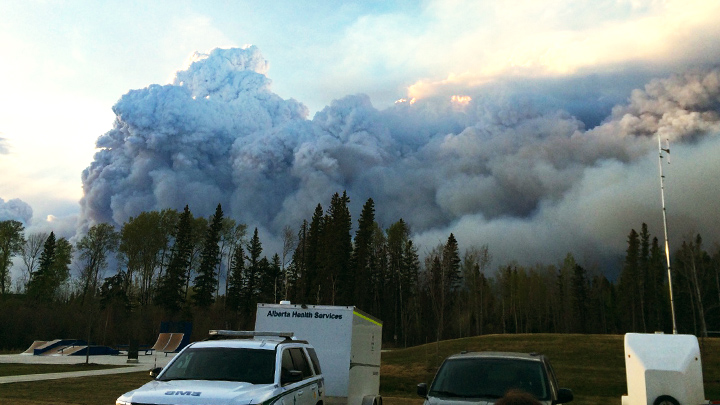
May 12, 2016

The EMS base in Anzac on Wednesday, May 4, 2016.
Story by Francis Silvaggio; Photo by EMS
Alfred Klein was on a routine trip to Fort McMurray, when the director of the Alberta Health Services (AHS) Emergency Medical Services (EMS) Southern Communication Centre found himself in the middle of Alberta’s worst wildfire disaster ever.
“It was pretty overwhelming,” said Klein, who was sent to the Northern Lights Regional Health Centre to conduct an EMS assessment of the patient evacuation process. “There were houses across the street that were burning down to the ground and, at that point, there weren’t any fire crews on scene.”
The fire spread quickly and so did the need for EMS and dispatch help. Wood Buffalo Regional Emergency Services is contracted to provide both EMS and dispatch services for AHS but with fire resources spread thin, AHS moved quickly to provide support.
“We made the decision to assume the full responsibility for EMS for the city of Fort McMurray,” said Darren Sandbeck, AHS Chief Paramedic. “That allowed our contractor to focus their staff entirely on the fire effort.”
In total, AHS sent seven ambulances, a specialized bus capable of caring for multiple patients, a mobile medical tent and two disaster trailers to provide on-going EMS support to emergency responders and evacuees.
AHS EMS transferred local dispatch services to the North Communications Centre, located in Peace River, and supported the medevac of the more than 90 patients (and a few pets) who had been evacuated from the Northern Lights Regional Health Centre, moving them to safety at Suncor’s Firebag airstrip
Paul Kennedy is executive director of Associated Ambulance, AHS’ largest contract provider. He was first to arrive at the medevac point to supervise the operation from the ground.
“I was involved with Slave Lake on the initial night of evacuations,” says Kennedy. “That operation went quite well but the cooperation in Fort McMurray was actually mind blowing.”
During the first night of evacuations, AHS EMS Air Ambulance used 15 different aircraft to fly more than 40 separate flights.
“I would suggest the Firebag aerodrome was one of the busiest airports around for a while,” said Sandbeck.
By Wednesday morning, the major part of the air operation was winding down just as additional ground crews arrived to support emergency responders and evacuees still under the shadow of the growing fire.
“We actually set up an EMS reception centre outside of Fire Hall 5 in Fort McMurray early on Wednesday morning,” said Rob Wiggins, Edmonton Metro Special Operations Supervisor. “It had only been established for a short period of time when we got the evacuation order that we needed to leave because the fire was coming up through that area.”
Wiggins’ crew relocated three times before finally setting up south of Fort McMurray at the Athabasca Open Camp. Once it was safe again, they moved back into Fort McMurray to provide ongoing EMS support.
An EMS peer support team has also deployed to the community to provide mental health and safety assistance to emergency responders who have stood guard as the fire ripped through their community.
A call for volunteers to support AHS EMS’ ongoing role in Fort McMurray resulted in more than 300 names in less than a day.
“Our staff have truly stepped up to the plate here,” said Sandbeck. “This is a team that I am, quite frankly, very proud to lead.”
After spending three days in the heart of the disaster, Klein could not agree more about his colleagues and emergency response partners.
“They are definitely a group of people willing to go above and beyond.”